
Nepenthes villosa, or the villose pitcher-plant, is a tropical pitcher plant endemic to Mount Kinabalu and neighbouring Mount Tambuyukon in northeastern Borneo. It grows at higher elevations than any other Bornean Nepenthes species, occurring at elevations of over 3,200 m (10,500 ft). Nepenthes villosa is characterised by its highly developed and intricate peristome, which distinguishes it from the closely related N. edwardsiana and N. macrophylla.

Nepenthes mirabilis, or the common swamp pitcher-plant and tropical pitcher plant, is a carnivorous plant species. By far the most widespread of all Nepenthes, its range covers continental Southeast Asia and all major islands of the Malay Archipelago, stretching from China in the north to Australia in the south. The species exhibits great variability throughout its range. One of the more notable varieties, N. mirabilis var. echinostoma, is endemic to Brunei and Sarawak and possesses an extremely wide peristome.

Nepenthes stenophylla, or the narrow-leaved pitcher-plant, is a tropical pitcher plant endemic to Borneo. The species produces attractive funnel-shaped pitchers up to 25 cm high. It is listed as Least Concern on the IUCN Red List. Nepenthes stenophylla belongs to the loosely defined "N. maxima complex", which also includes, among other species, N. boschiana, N. chaniana, N. epiphytica, N. eymae, N. faizaliana, N. fusca, N. klossii, N. maxima, N. platychila, and N. vogelii.

Nepenthes pilosa is a tropical pitcher plant endemic to Borneo. It is characterised by a dense indumentum of long yellow-brown hairs. Pitchers have a distinctive hook-shaped appendage on the underside of the lid. The specific epithet derives from the Latin word pilosus, meaning "hairy".
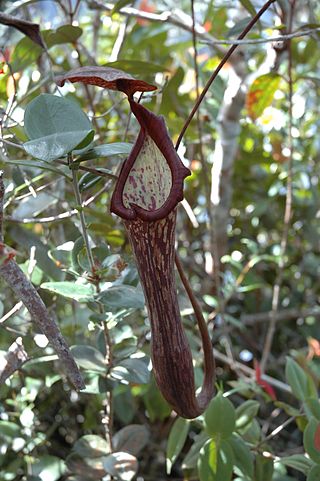
Nepenthes faizaliana is a tropical pitcher plant endemic to the limestone cliffs of Gunung Mulu National Park in Sarawak, Borneo. It is thought to be most closely related to N. boschiana.

Nepenthes mapuluensis, the Mapulu pitcher-plant, is a species of tropical pitcher plant native to East Kalimantan, Borneo. It is known only from a restricted geographical range and is listed as Endangered on the IUCN Red List.

Nepenthes adnata is a tropical pitcher plant endemic to the Indonesian province of West Sumatra, where it grows at elevations of 600 to 1200 m above sea level. The specific epithet adnata is Latin for "broadly attached" and refers to the base of the lamina.

Nepenthes benstonei is a tropical pitcher plant endemic to Peninsular Malaysia, where it grows at elevations of 150–1350 m above sea level. The specific epithet benstonei honours botanist Benjamin Clemens Stone, who was one of the first to collect the species.

Nepenthes glabrata is a tropical pitcher plant endemic to Sulawesi. The species grows in open, high forest at elevations of 1600 to 2100 m. It produces dainty, colourful pitchers reaching only a few centimetres in height. These traps are red speckled on a yellowish background, giving them a "hand painted" appearance.
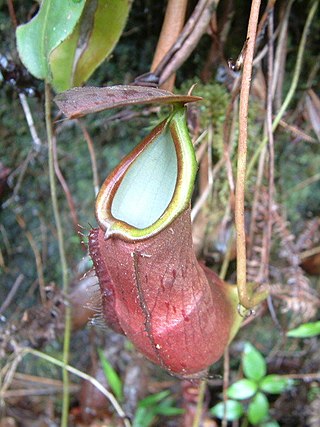
Nepenthes longifolia is a tropical pitcher plant endemic to Sumatra, where it grows at elevations of between 300 and 1100 m above sea level. The specific epithet longifolia, formed from the Latin words longus (long) and folius (leaf), refers to the exceptionally large leaves of this species.
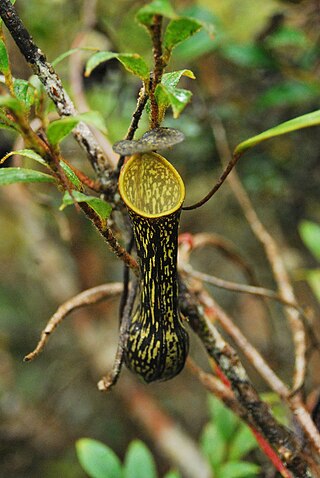
Nepenthes mikei is a tropical pitcher plant endemic to Sumatra. It is characterised by its black mottled lower and upper pitchers. The species is closely related to N. angasanensis and N. tobaica.

Nepenthes tomoriana is a species of pitcher plant endemic to Sulawesi, where it grows at an elevation of 0–500 m above sea level.

Nepenthes neoguineensis is a tropical pitcher plant native to the island of New Guinea, after which it is named.

Nepenthes rhombicaulis is a tropical pitcher plant endemic to Sumatra. The specific epithet rhombicaulis is formed from the Latin words rhombicus, meaning "rhomboid", and caulis, "stem". It refers to the cross-sectional shape of the stem internodes.
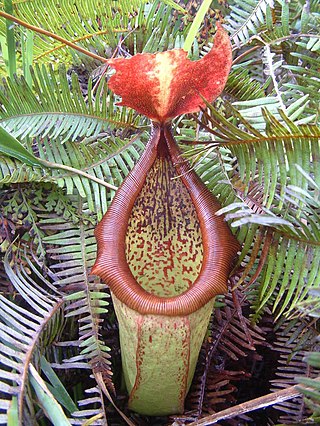
Nepenthes insignis is a tropical pitcher plant endemic to New Guinea and surrounding islands. The specific epithet insignis is Latin for "distinguished" or "remarkable".

Nepenthes smilesii is a tropical pitcher plant native to northeastern Thailand, southern Laos, Cambodia, and Vietnam. Nepenthes smilesii can tolerate an extended dry season and is most common in open, sandy savannah and grassland.
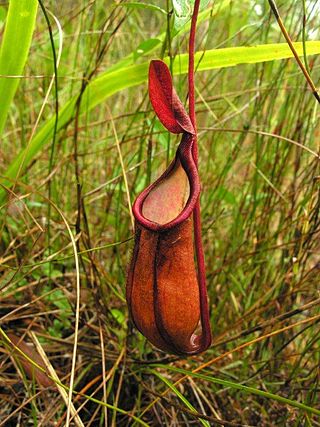
Nepenthes kampotiana is a tropical pitcher plant native to southern Cambodia, eastern Thailand, and at least southern coastal Vietnam. It has an altitudinal distribution of 0–600 m above sea level. The specific epithet kampotiana refers to the Cambodian city of Kampot, close to which the first specimens of this species were collected.
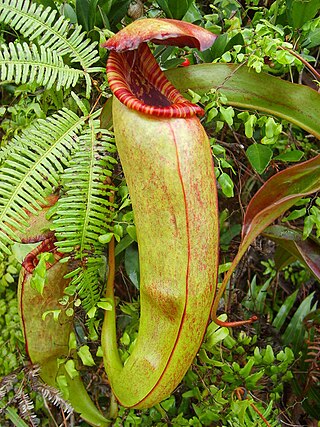
Nepenthes bokorensis is a tropical pitcher plant endemic to Cambodia. It is known from Mount Bokor in the south of the country, and an as yet undetermined specimen suggests that it may also be present in other parts of the Dâmrei Mountains of Kampot Province. The specific epithet bokorensis refers to both Mount Bokor and Bokor National Park.
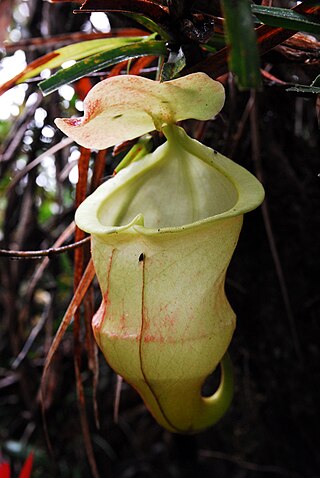
Nepenthes hamiguitanensis is a tropical pitcher plant endemic to a single peak on the Philippine island of Mindanao, where it grows at elevations of 1200–1600 m above sea level. Once thought to be a natural hybrid between N. micramphora and N. peltata, this plant is now considered a species of possible hybridogenic origin. It produces squat upper pitchers that vary greatly in pigmentation, from red speckled to yellow throughout.
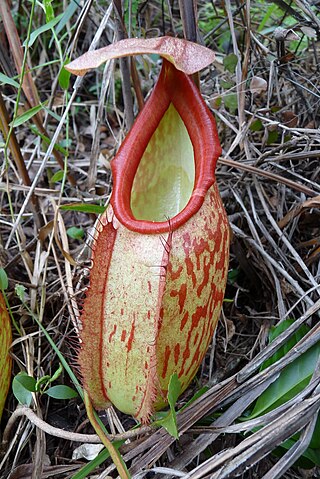
Nepenthes holdenii is a tropical pitcher plant from western Cambodia, where it grows at elevations of 600–800 m above sea level. The species was originally known from only two peaks in the Cardamom Mountains, but the discovery of a new population was reported in October 2011. Seeds were collected in 2014 and the species was successfully introduced into cultivation.




























